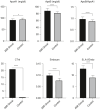Relationship between angiogenesis biomarker endocan and apolipoproteins in patients with acute myocardial infarction
- PMID: 38967435
- PMCID: PMC11486116
- DOI: 10.1080/14796678.2024.2365552
Relationship between angiogenesis biomarker endocan and apolipoproteins in patients with acute myocardial infarction
Abstract
Aim: In the current study, serum levels of endocan in patients attended with ST-elevation myocardial infarction, as well as the possible correlation with apolipoprotein-A1 (APO-A1) and APO-B were investigated.Materials & methods: In 80 men, endocan, cTnI, APO-A1, and APO-B levels were measured. Finally, the correlation of endocan with APO-A1, APO-B, and APO-B/ APO-A1 ratio was assessed.Results: Significant changes in APO-A1, APO-B, endocan levels, and APO-B/APO-A1 ratio were found in acute myocardial infarction cases compared with the control arm (p < 0.05). In addition, our finding showed a significant correlation between APO-B and endocan levels, but not APO-A.Conclusion: High endocan level is an independent indicator of endothelial dysfunction and ischemic cardiovascular conditions, which could be related to APO-B.
Keywords: ST-elevation myocardial infarction; acute myocardial infarction; angiogenesis; apolipoproteins; endocan; reliable indicator.
Plain language summary
[Box: see text].
Conflict of interest statement
The authors have no competing interests or relevant affiliations with any organization or entity with the subject matter or materials discussed in the manuscript. This includes employment, consultancies, honoraria, stock ownership or options, expert testimony, grants or patents received or pending, or royalties.
Figures

Similar articles
-
Association of plasma endocan levels with metabolic parameters and predictive value of endocan for the development of complications in patients with type 2 diabetes mellitus: An observational study.Biomol Biomed. 2025 May 8;25(7):1522-1527. doi: 10.17305/bb.2024.11512. Biomol Biomed. 2025. PMID: 39720951 Free PMC article.
-
The relationship of glycosylated hemoglobin A1c and Apolipoprotein A‑1 ratio on short-term prognosis in STEMI patients following PCI: a retrospective study.Sci Rep. 2025 Apr 23;15(1):14110. doi: 10.1038/s41598-025-99003-x. Sci Rep. 2025. PMID: 40269200 Free PMC article.
-
Assessing Serum Apolipoproteins A-I and b100 and the Apo A-I/Apo b100 Ratio in Relation to Premature Coronary Artery Disease and Its Severity.Catheter Cardiovasc Interv. 2025 Jul;106(1):153-162. doi: 10.1002/ccd.31497. Epub 2025 Apr 8. Catheter Cardiovasc Interv. 2025. PMID: 40200668
-
Diagnostic Role of Circulating Endocan Levels in Obstructive Sleep Apnea: A Systematic Review and Meta-Analysis.Angiology. 2024 Jul;75(6):505-516. doi: 10.1177/00033197231183087. Epub 2023 Jun 8. Angiology. 2024. PMID: 37290048
-
Beta-blockers in patients without heart failure after myocardial infarction.Cochrane Database Syst Rev. 2021 Nov 5;11(11):CD012565. doi: 10.1002/14651858.CD012565.pub2. Cochrane Database Syst Rev. 2021. PMID: 34739733 Free PMC article.
References
-
- Osho A, Fernandes MF, Poudel R, et al. Race-based differences in ST-segment–elevation myocardial infarction process metrics and mortality from 2015 through 2021: an analysis of 178 062 patients from the American Heart Association get with the guidelines–coronary artery disease registry. Circulation. 2023;148(3):229–240. doi: 10.1161/CIRCULATIONAHA.123.065512 - DOI - PubMed
-
- Corbo R, Vilardo T, Mantuano E, et al. Apolipoproteins B and E, and angiotensin I‐converting enzyme (ACE) genetic polymorphisms in Italian women with coronary artery disease (CAD) and their relationships with plasma lipid and apolipoprotein levels. Clin Genet. 1997;52(2):77–82. doi: 10.1111/j.1399-0004.1997.tb02522.x - DOI - PubMed
MeSH terms
Substances
LinkOut - more resources
Full Text Sources
Research Materials
Miscellaneous
